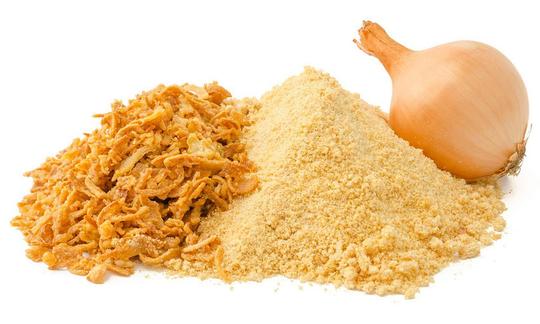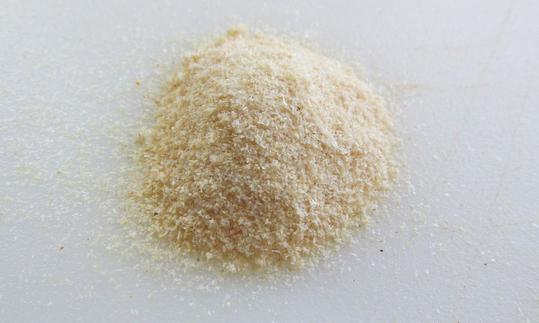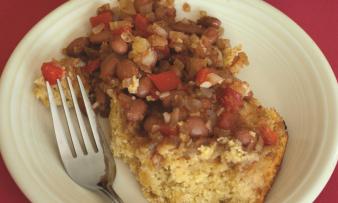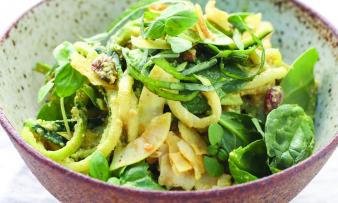Table of contents
Onion granules consist of chopped dried onions ( Allium cepa L.). Onion powder is the finer version and can almost always be used in the same way. It is rarely raw , but is available as an organic product.
Use in the kitchen
During the drying process, only water is removed from the onions, so that the natural aroma is retained as much as possible. The heat changes the taste of onion powder or onion granules: it is sweeter than fresh onions; the scent is also different.
What is onion granulate? In contrast to fine onion powder, onion granulate is grainier and has more texture. However, it is finer than onion flakes (dried onions). However, the names in the trade can be misleading, as can the information on the diameter of the grains/pieces.
The use of onion granules or onion powder is comparable to that of fresh onions, with a few exceptions (stuffed onions, etc.). Both are suitable for seasoning and refining vegan soups, sauces, raw food dips, various marinades, chutneys, dressings, salads and vegetable dishes. Instead of fresh onions, you can cook onion powder with the ingredients or simply add it to cold creations.
When adding to solid foods, it is advisable to mix the onion granules with a little water to ensure even distribution. This process is even more important with onion powder. In contrast to raw onion pieces, the use of granules or powder is usually "tearless" and is also a way to make a dish with onion flavor palatable to small children despite the visual absence of onions.
Onion granules and onion powder taste much more intense than fresh onions because they are concentrated. How much onion powder is equivalent to one onion? This question is not so easy to answer because even fresh onions can be of varying degrees of spiciness or taste different. A teaspoon of onion powder is approximately equivalent to 1 ½ tablespoons of chopped fresh onions. How much onion granules is equivalent to one onion? A tablespoon of onion granules (or onion powder) is approximately equivalent to one medium-sized onion.
Use powder and granules sparingly and taste carefully. We recommend using natural ingredients, i.e. raw onions : they are healthier. Purchased onion powder is rarely raw, depending on the drying process (steam pressure process, freeze drying, etc.). High drying temperatures also reduce the spiciness of the dried product. 23
On the other hand, onion granules or onion powder - as well as garlic granules or garlic powder - are real time savers and can be stored much better.
Homemade preparation
Can you make onion granules yourself? It's worth making them yourself, especially if you rarely use onions or garlic or only use them in small quantities. This way you can also store leftover onions for much longer.
The preparation of onion granules or onion powder using a heating process (instead of gentle industrial drying) is simple:
Peel organic onions and cut into thin slices; it is easier and quicker to use a slicer (eg truffle slicer). Spread the onion slices on baking paper and make sure that they do not lie on top of each other. The slices should not be thicker than 1-2 mm. An average baking tray holds about 4 onions.
If the oven has no ventilation, keep it slightly open by jamming a piece of metal or wood into it. A gentler way to do this is to use a dehydrator that you set to 40 to 42 °C and a drying time of around 6 hours. The thinner the slices, the faster the drying process. This means that the onions retain their vitamins and raw food quality. The color of the onions remains the same or only changes slightly towards light beige.
It is important that the moisture can escape so that the onion slices are dry on the inside too. The (thickest) slices should break instead of bending if they are dry enough. Once the onion slices are dry and cooled, mix, grind or pound them into a powder - fineness depends on your needs. You can do this using a blender, a spice grinder, an electric coffee grinder, a mortar or a food processor with blades.
If you cannot set it to 40 or 42 °C because the device only works at 50 °C, you can dry it gently in a preheated oven with ventilation at 50 °C. This process takes about 5 hours. You can adjust the heat and time as needed.
If you want browning, use around 140 °C for 30 minutes initially and then reduce to 100 °C for around an hour. We advise against this heat because it creates unhealthy Maillard molecules ( Maillard reaction ). These are non-enzymatic browning reactions that we usually like and find attractive. This creates potentially carcinogenic substances such as acrylamide. They start to form at temperatures of 170 to 190 °C - but also take effect at lower temperatures, albeit more slowly.
Theoretically, you can also dry onions in warm air, e.g. on a radiator. Even if the air in the room is dry, this will take 3 to 4 days. Due to the longer contact with air, more ingredients, e.g. vitamins, oxidize.
Vegan recipe for zucchini and potato rosti
Ingredients (for 4 people): 100 g raw zucchini , 300 g boiled potatoes , 1 pinch of onion powder (organic), grated nutmeg , salt ,pepper , oil for frying (e.g. rapeseed orsunflower oil ).
Preparation: Coarsely grate raw zucchini and boiled potatoes and mix with the spices. Put the whole mixture into a well-oiled pan, press down and fry for about 10 minutes at medium heat. Turn: Using a lid, turn the pan over and let the contents slide back into the pan. Now finish frying the vegan rösti on the other side and enjoy.
Vegan recipes with onion granules or onion powder can be found under the note: " Recipes that have the most of this ingredient ".
| Not only vegans or vegetarians should read this: Vegans often eat unhealthily. Avoidable nutritional errors . |
Purchasing - Storage
Onion granules or onion powder from conventional cultivation and processing are available from most common supermarket chains such as Coop , Migros , Denner , Volg , Spar , Aldi , Lidl , Rewe , Edeka , Hofer , Billa etc. What are granulated onions? The product name 'granulated onions' is also common, probably based on the English (=granulate).
Since organically produced onions contain more minerals and trace elements, 9 we recommend buying powder or granules with an organic seal. You can find these in health food stores, organic shops, organic supermarkets (e.g. Denn's Biomarkt , Alnatura ) or in some delicatessens.
Prefer products that do not contain additives such as salt, spices or flavor enhancers.
The availability of onion granules and onion powder (finely ground) varies depending on the size of the store, catchment area, etc. If you are interested, click on our recorded food prices for the DA-CH countries (above under the ingredient image). There you will find current prices from various supermarkets and their price development.
Storage tips
If stored properly, i.e. dry, protected from light and hermetically sealed, onion granules or powder will last for a year - and if dried perfectly, even several years. If onion granules or onion powder darken, this is a sign that they are starting to rot. This can happen, for example, if you leave the container open for too long, especially in humid air.
Ingredients - Nutritional values - Calories
Since there is hardly any water to be found in onion granules and onion powder (in contrast to fresh onions), the carbohydrate content increases several times to 79 g/100g. Dried onions taste sweeter than fresh ones because the glycosidic compounds they contain release sugar when heated. They contain 6.6 g of sugar per 100 g. The fiber content is 15 g/100g, the protein content 10 g/100g and there is hardly any fat (1 g/100g). The calorie content per 100 g is 341 kcal.
Per 100 g, the powder or granules contain more vitamins and trace elements (optimally when dried gently 23 ), but you only consume a small amount of them. Read more about the ingredient Dried Onions .
In comparison, raw onions (146 mg/100g) have much less potassium than onion granules (985 mg/100). Potassium is important for cell membranes and cell growth. Dried herbs ( dried parsley : 2680 mg/100g) and pulses ( white beans : 1795 mg) contain a lot of potassium. 1
Manganese is present in onion powder at 1.3 mg/100g. This trace element helps in the formation of cartilage and connective tissue. Germs ( wheat germ : 13 mg/100g) or nuts ( hazelnuts : 6 mg/100g) contain larger amounts of it. 1
The essential mineral calcium is contained in onion granules at 384 mg/100g. It is important for the stability of bones and teeth. Green herbs and vegetables have particularly high calcium values, such as fresh basil (177 mg) or rocket (160 mg). 1
Onion powder contains a significant amount of phosphorus , 322 mg/100g. Not only calcium, but also phosphorus is important for teeth, bones and cell membranes. Chia seeds have a high content of 860 mg/100g, and oat flakes are similar to onion powder. 1
The trace element sulfur is a component of the essential oil that is responsible for the typical smell of fresh onions - but is also found in the amino acids. Onions have a high content of quercetin, an effective flavonoid. 2,3,10 Flavonoids are barely present or no longer present in commercial onion powders or onion granules (the study cited examined 16 products from the USA). 3 Flavonoids are most concentrated in the onion skin. 5
Onions ( Allium cepa L.) do not contain starch, but mainly fructans (fructans) as reserve substances. 20
The complete ingredients of onion granules and onion powder, the coverage of the daily requirement and comparison values with other ingredients can be found in our nutrient tables. In the article Nutrients explained you will get a detailed insight into the topic.
Effects on health
Is onion powder healthy? The NHV Theophrastus has chosen onions as the medicinal plant of the year 2015. Antioxidant sulfur compounds in onions and other secondary plant substances have antibacterial effects and slightly lower blood pressure, blood fats and blood sugar. 20 Reducing the latter factors reduces the risk of heart disease; however, with onion powder, a lot depends on gentle drying and processing.
The flavonoids contained in onions improve blood circulation and prevent blood clots and arteriosclerosis by blocking the oxidation of lipoproteins. The essential oil and flavonoids are said to have antibiotic, bronchial, anti-asthmatic, cardio-vascular, diuretic and anti-cancer properties. 2 When taken internally (raw, cooked, fried, as a syrup, etc.), onions are effective against all types of respiratory diseases. 2
The human digestive system cannot break down fructans enzymatically and reabsorb them in the small intestine. Bacteria metabolize the fructans undigested in the large intestine: This produces gas (flatulence). The odor (after flatulence) is caused not only by the breakdown products of the fructans but also by those of the sulfur-containing ingredients. However, inulin-type fructans, such as those found in onions, offer health benefits, including improved laxation, insulin sensitivity, intestinal barrier function, satiety and mineral absorption, as well as reduced triglyceride concentration in the blood. 20
A 2015 study examined the best-known health studies on onions and garlic and described the individual results. It comes to the following conclusion regarding cancer prevention: Science points to possible mechanisms of the anti-cancer activity of various Allium plant extracts and preparations and underlines the effects of sulfur-containing compounds. These compounds have effects at every stage of carcinogenesis and influence many physiological processes that positively modify the risk of cancer. 6 You can find more details under the ingredient Dried Onions .
Another study shows that the activity against free radicals correlates with the total phenol content of Allium plants (the study found the highest activity in red onions; yellow onions were also significantly better at scavengers of free radicals than garlic). 10 This antioxidant strategy is crucial for the prevention and treatment of cancer by inhibiting cancer cell proliferation. 7
Dangers - Intolerances - Side effects
Although most onions are poisonous or indigestible for humans, kitchen onions are actually used to maintain our health. However, they can be poisonous for certain mammals (eg small mammals, dogs and cats, horses). This also applies to onion powder and onion granules.
Some allergy sufferers may develop contact eczema (as with garlic); low-molecular sulfur compounds are considered allergens. Onions also contain other proteins that can trigger allergies: lipid transfer protein (All c 3), profilin (All c 4, cross-allergen with grass pollen), alliin lyase (cross-allergen with other types of allium). 4
Ecological footprint - animal welfare
Despite extensive research, we were unable to find any precise figures on the ecological footprint of onion granules (onion powder). The figures depend on the individual production processes, starting with onion production, subsequent processing and finally packaging. Regionally grown onions have a low carbon footprint (0.2 kg CO 2 eq/kg). 11 In a study on the environmental impact of onion cultivation, it was found that the equipment required and the corresponding electricity have the largest share of the environmental impact. In addition, small farms have a greater impact on global warming than larger ones. 12 Research is currently being carried out into the use of solar energy to dry onions, as this could be an environmentally friendly alternative to conventional methods. 14
The amount of water required to produce 1 kg of dried onions is 345 litres, which is slightly higher than the amount required for onions (272 litres). 13 A study of the water footprint of dried onions in Nigeria showed that water reserves are used for irrigation. This has a particularly negative impact in a country with a prevalent water shortage. Ideally, rainwater is used instead. 15
Worldwide occurrence - cultivation
The onion is one of the oldest cultivated plants. It has been used as a medicinal plant, spice and vegetable for thousands of years. Since there are no direct wild ancestors of this Allium species, the geographical origin cannot be clearly determined. 18 According to pharmacist M. Pahlow, summer onions originate from western Asia and the Romans brought them to Central Europe. In the Balkan countries and the Orient, the onion is a more important vegetable plant than in western countries. 5
When the first dehydration experiments were carried out towards the end of the 18th century, they were also tested on onions. In the 1920s, an extensive program for drying onions and garlic was started in California. Commercial drying processes became established at the beginning of the Second World War. 19
Organic farmers struggle with pesticide-free onion cultivation, especially with the high weed pressure. Downy mildew can also lead to significant crop failures. For this reason, organic onions are significantly more expensive than conventionally grown ones. 9
According to BioSuisse, onion powder, cubes and granules as imported Bud raw materials come mainly from Egypt and Germany (imports serve to supplement the domestic supply).
Industrial production
The most commonly used modern drying methods for onions are sun drying or solar drying, convective air drying, solar greenhouse drying (GHD) and infrared drying. 21
For classic hot air drying, the onions are stored in special tanks for 48 to 72 hours after harvest. These are heated with hot air (38 °C) so that the onions are easier to peel. After the onion roots have been removed, the onions are washed in a high-pressure cleaner and placed in a bath of chlorinated water to reduce bacteria to a minimum. The onions are then cut into thin slices by machine. Drying takes place on belts with hot air in several steps: first at hot temperatures (82-104 °C) to reduce the moisture content from 83% to 25%. Then drying takes place at lower temperatures to a moisture content of 4-6%. After drying, the onions are transported to be milled. In the mill, the skin of the onion pieces is first removed by blower. Finally, the onions are cut, chopped, ground or granulated before being packaged. 16
Freeze-dried onions are produced using the same process as freeze-dried herbs. The chopped onions are shock-cooled to -18 °C using liquid nitrogen. In a vacuum, the resulting ice turns directly into a gaseous state (water vapor) and can be easily sucked out. Although this technique is more expensive, it ensures that the product retains its structure, natural color and flavor even when stored for a long time. 17
Further information
The onion ( Allium cepa ) belongs to the leek genus ( Allium ). In the botanical sense, when referring to onions, it is always necessary to clarify whether it is Allium cepa or a part of a plant - a possible form of the plant's storage organ.
Onion powder is also made from red onions . Winter onions (or spring onions or scallions) are generally not used to produce onion granules or powder.
Alternative names
onion powder (onion powder) or onion granules (onion granules) can also be referred to as ground or granulated onions.
In English, onion powder is called onion granules and onion granules are known as onion powder or granulated onion.
Bibliography - 10 Sources
| 1. | USDA - United States Department of Agriculture. |
| 2. | Roger P. Heilkräfte der Natur: Ein Praxishandbuch. Zürich: Advent Verlag. 2006. 142-146. |
| 3. | Lee S, Lee J, Choi S et al. Flavonoid Content in Fresh, Home-Processed, and Light-Exposed Onoins and in Dehydrated Commercial Onion Products. Journal of Agricultural and Food Chemistry. 2008. 56(18). |
| 4. | Enrique E, Malek T, Mateo J et al. Involvement of lipid transfer protein in onion allergy. Annals of Allergy, Asthma & Immunology. 2007;98(2):202. |
| 5. | Pahlow M. Das grosse Buch der Heilpflanzen. Nikol Verlag. 2013. |
| 6. | Nicastro HL, Ross SA, Milner JA. Garlic and onions: Their cancer prevention properties. Cancer prevention research (Philadelphia, Pa). 2015;8(3). |
| 7. | Jafari S, Saeidnia S, Abdollahi M. Role of natural phenolic compounds in cancer chemoprevention via regulation of the cell cycle. Curr Pharm Biotechnol. 2014;15(4). |
| 9. | Pini U. Das Bio-Food Handbuch. Ullmann: Hamburg, Potsdam. 2014. |
| 10. | Jessen C. Die deutschen Volksnamen der Pflanzen. Verlag von Phiolipp Cohen: Hannover. 1882. |
| 11. | Online Etymology Dictionary. Onion (n.). |












Comments